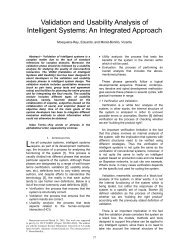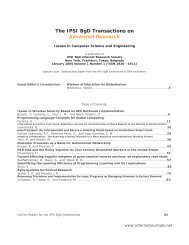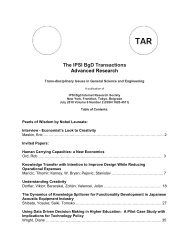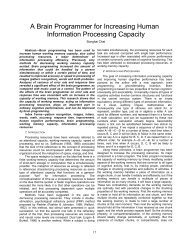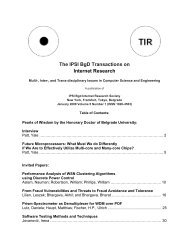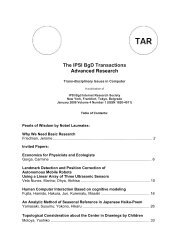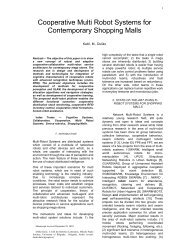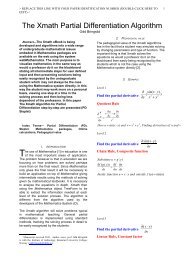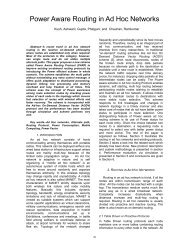The IPSI BgD Transactions on Internet Research - Welcome
The IPSI BgD Transactions on Internet Research - Welcome
The IPSI BgD Transactions on Internet Research - Welcome
Create successful ePaper yourself
Turn your PDF publications into a flip-book with our unique Google optimized e-Paper software.
Implementing Numerical Reas<strong>on</strong>ing in ILP<br />
Demšar, Damjan 1 and Gams, Matjaž 1<br />
Abstract - We introduce the 4S system capable<br />
of handling numerical problems within the general<br />
Inductive Logic Programming (ILP) framework.<br />
Previous systems had severe problems with<br />
handling numerical domains, as well as with using<br />
background knowledge and multi-relati<strong>on</strong>al data at<br />
the same time. <str<strong>on</strong>g>The</str<strong>on</strong>g> idea introduced in 4S is that<br />
regressi<strong>on</strong> results are integrated into an ILP<br />
program as numerical formulas. A formula is<br />
created dynamically according to the available<br />
examples and hypotheses. In this way, 4S can deal<br />
with numerical problems presented in multirelati<strong>on</strong>al<br />
data by using background knowledge.<br />
<str<strong>on</strong>g>The</str<strong>on</strong>g> logic-based and numeric-based techniques in<br />
4S collide in the presence of complex recursi<strong>on</strong>,<br />
but we believe that the functi<strong>on</strong>al power of our<br />
system is less limited than related <strong>on</strong>es. We<br />
analyze the performance of 4S.<br />
Inductive logic programming, Linear regressi<strong>on</strong>,<br />
Machine learning<br />
1. INTRODUCTION<br />
Various attempts have been made to<br />
implement Inductive Logic Programming (ILP)<br />
systems that are capable of handling numerical<br />
data [4], [22], [29], [30]. <str<strong>on</strong>g>The</str<strong>on</strong>g> general idea is to<br />
combine ILP with numerical manipulati<strong>on</strong> in order<br />
to enlarge the space of problem domains that can<br />
be successfully tackled by ILP systems. Basic<br />
ILP has several advantages [21], such as the<br />
ability to deal with data stored in multiple<br />
relati<strong>on</strong>al tables and to take into account<br />
background (domain) knowledge expressed as a<br />
logic program. ILP also uses powerful expressi<strong>on</strong><br />
language to describe logical relati<strong>on</strong>s.<br />
Pure ILP, however, is not capable of handling<br />
numerical data [2], especially when the output<br />
“class variable” is c<strong>on</strong>tinuous. ILP systems<br />
usually do not differentiate input and output<br />
variables, while numerical problems often involve<br />
differentiati<strong>on</strong>. By itself, ILP cannot even perform<br />
such numerical functi<strong>on</strong>s as (in)equalities,<br />
arithmetic, trig<strong>on</strong>ometry, geometry and linear<br />
regressi<strong>on</strong>. Of these, regressi<strong>on</strong> is the most<br />
relevant <strong>on</strong>e in machine-learning problems since<br />
numerous real-life models can be approximated<br />
by formulas. Regressi<strong>on</strong> enables c<strong>on</strong>structi<strong>on</strong> of<br />
1 Jožef Stefan Institute, Ljubljana, Slovenia<br />
{damjan.demsar, matjaz.gams}@ijs.si<br />
40<br />
a formula from a given set of examples, but it<br />
lacks logical mechanisms for c<strong>on</strong>structing more<br />
advanced logical models <strong>on</strong> top of formulas. ILP<br />
and regressi<strong>on</strong> are therefore ideal for combining<br />
different advantages into an advanced integrated<br />
system, which we refer to as first order<br />
regressi<strong>on</strong> [14].<br />
FORS [14] (First Order Regressi<strong>on</strong> System)<br />
was <strong>on</strong>e of the first implemented ILP systems<br />
capable of handling numerical data. First Order<br />
Regressi<strong>on</strong> is an integrati<strong>on</strong> of (first order logic)<br />
Inductive Logic Programming and numerical<br />
regressi<strong>on</strong>. After first experiments with the<br />
implemented FORS system, we started with an<br />
advanced algorithm and system 4S.<br />
<str<strong>on</strong>g>The</str<strong>on</strong>g> paper is organized as follows: In Secti<strong>on</strong> 2<br />
we describe definiti<strong>on</strong>s of ILP, regressi<strong>on</strong> and<br />
integrati<strong>on</strong>. In Secti<strong>on</strong>s 3 and 4 we describe the<br />
4S [6] system as an algorithm and as a fully<br />
operati<strong>on</strong>al program. In Secti<strong>on</strong> 6 we present<br />
tests <strong>on</strong> artificial and real-world problems.<br />
2. ILP, REGRESSION AND FIRST ORDER REGRESSION<br />
For our purposes, ILP can be defined in the<br />
following way:<br />
• B is background knowledge c<strong>on</strong>sisting of a<br />
set of definite clauses<br />
• E is a set of examples E = E + ∪ E - where:<br />
• E + = {e 1 , e 2 ,…} are positive examples that are<br />
definite clauses, often ground unit clauses.<br />
• E - = { f<br />
1, f<br />
2<br />
,K}<br />
are negative examples that<br />
are Horn clauses, often ground unit clauses.<br />
• B |≠ E + , where X |= Y denotes semantic<br />
entailment of Y by X<br />
• Given B and E, the output is a set of definite<br />
clauses H = {D 1 , D 2 ,…}, that is a complete<br />
and c<strong>on</strong>sistent explanati<strong>on</strong> of the examples,<br />
from a predefined language L. H usually<br />
satisfies at least the following c<strong>on</strong>diti<strong>on</strong>s:<br />
o Each D i explains at least <strong>on</strong>e positive<br />
example. That is B ∧ D i |= e j ∨ e k ∨ …,<br />
where e m ∈ E +<br />
o B ∧ H |= E +<br />
o B ∧ H |≠ f, f∈E -<br />
Linear regressi<strong>on</strong> is defined as follows:<br />
• E is a set of examples in the form y n =f(x 1,n ,<br />
x 2,n , …,x m,n ), where x i,j are real-valued



